firefighters
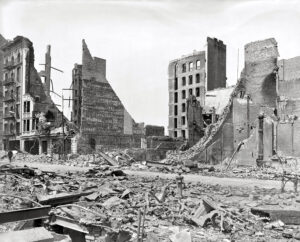 On April 18, 1906, many of the people in the San Francisco, California area were sound asleep in their beds. It was, after all, 5:13am. Suddenly, the people were jolted awake by an earthquake, which was estimated to be close to 8.0 on the Richter scale. When the quake struck San Francisco, California, it toppled numerous buildings. The cause of the quake was a slip of the San Andreas Fault over a segment about 275 miles long. The resulting shock waves could be felt from southern Oregon down to Los Angeles.
On April 18, 1906, many of the people in the San Francisco, California area were sound asleep in their beds. It was, after all, 5:13am. Suddenly, the people were jolted awake by an earthquake, which was estimated to be close to 8.0 on the Richter scale. When the quake struck San Francisco, California, it toppled numerous buildings. The cause of the quake was a slip of the San Andreas Fault over a segment about 275 miles long. The resulting shock waves could be felt from southern Oregon down to Los Angeles.
At that time, San Francisco’s had a variety of brick buildings and wooden Victorian structures that were not really earthquake reinforced. Nobody knew about making buildings strong enough to resist destruction from an earthquake. It was one of the things we would learn from the results of a disaster. It seems that with each disaster, we learn how to prevent the loss of so many buildings and lives. The old buildings were devastated. Along with the collapsed buildings, came devastating fires, and because many of the water mains had broken, firefighters were prevented from stopping 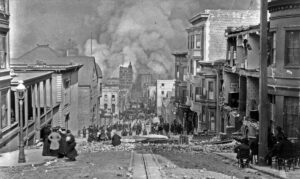 the fires. Firestorms soon developed citywide. US Army troops from Fort Mason reported to the Hall of Justice around 7am, and San Francisco Mayor E.E. Schmitz set a dusk-to-dawn curfew and authorized soldiers to shoot to kill anyone found looting. Disasters like these always seem to bring out the worst in people, even those who might not have done such things under normal circumstances.
the fires. Firestorms soon developed citywide. US Army troops from Fort Mason reported to the Hall of Justice around 7am, and San Francisco Mayor E.E. Schmitz set a dusk-to-dawn curfew and authorized soldiers to shoot to kill anyone found looting. Disasters like these always seem to bring out the worst in people, even those who might not have done such things under normal circumstances.
As significant aftershocks continued, firefighters and US troops fought desperately to control the ongoing fires. Sadly, that sometimes meant dynamiting whole city blocks to create firewalls. Many people were trapped where they were, because the fires prevented their escape, even though they were not stuck in a collapsed building. Finally, on April 20th, several thousands of refugees were evacuated from the foot of Van Ness Avenue. The army would eventually house 20,000 refugees in more than 20 military-style tent camps across the city. The people had no idea how long they might have to be there.

Most of the fires were extinguished by April 23rd, and the authorities started the task of rebuilding the devastated city. In all, approximately 3,000 people lost their lives as a result of the Great San Francisco Earthquake and the devastating fires it inflicted upon the city. Almost 30,000 buildings were destroyed, including most of the city’s homes and nearly all the central business district. The rebuilding would take a long time, and the new structures were reinforced to be able to better withstand the shaking of the San Andreas fault. This quake may not have been the “Big One” that is predicted, but at an estimated 7.9 or 8.0, it was right up there.
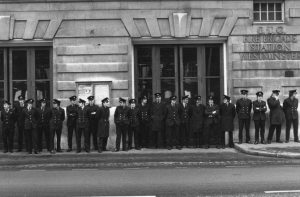 When we think of emergency personnel, we think of people who willingly put their lives on the line for others, and that is a good analogy, but while these people are passionate about their career, it is still a career. They expect, and need to be paid accordingly. Their job is dangerous, and they risk their lives every day, to go out and save other people. Unfortunately, they have to make a living too. For firefighters in England in 1977, the living they were making, wasn’t enough to support their families. So, as often happens, when the pay doesn’t equal the risk, the firefighters went on strike. They were demanding a 30% raise in pay.
When we think of emergency personnel, we think of people who willingly put their lives on the line for others, and that is a good analogy, but while these people are passionate about their career, it is still a career. They expect, and need to be paid accordingly. Their job is dangerous, and they risk their lives every day, to go out and save other people. Unfortunately, they have to make a living too. For firefighters in England in 1977, the living they were making, wasn’t enough to support their families. So, as often happens, when the pay doesn’t equal the risk, the firefighters went on strike. They were demanding a 30% raise in pay.
As the strike began, the 30,000 strong Fire Brigades Union claimed that 97.5% of its members had heeded the strike call and were no longer manning the pumps. It doesn’t take much imagination to realize that without firefighters, the cities were in serious trouble. Talks continued between union leaders and employers, but it didn’t look like there would be an early resolution, because the government insisted there was no breach of its 10% public sector pay ceiling.
As the situation became more critical, troops were brought in to provide emergency coverage of the cities. There was still concern among the soldiers about their lack of training and modern firefighting equipment. They would do their jobs, but that didn’t mean that they would know how to do it well. The reality is that firefighting is a highly skilled job, in which the people are trained, and they know the risks.
The firefighters said that they had already waited two years for the Government to consider their pay claim…and they were done waiting. During that two years, the police department had received a substantial pay rise while firefighters, in line with many others, had to settle for £6 per week. Much of the discussion between the union and employers is focused on the possibility of a reduction in the 48-hour working week, which would allow officers to earn considerable overtime payments.
In many areas firefighters have deserted their stations only reluctantly. Firemen, still wearing their uniforms and pickets armbands, rushed to the scene of a fire at St Andrew’s Hospital in Bow, East London, after a basement storeroom caught light. One of the officers said: “We couldn’t let them die.” And, “It was a hospital, what else could we do but come and help?” A colleague Barry Holmes said: “The situation here was really dangerous and people could have died if we had not come.” Emergency troops arrived at the scene first, and fire officers said afterwards that without their help the building would have burned to the ground.
“Elsewhere in the country, troops averted a major catastrophe on Merseyside when they stopped a haulage depot blaze at Kirkdale spreading to a 500 gallon gasoline storage tank. A woman and her twin sons escaped from a bungalow at Wallington in Surrey after a gas container exploded starting a fire. Troops in a Green Goddess had to drive 25 minutes from Croydon and the house was destroyed. The local fire station was less than three minutes drive away.” The striking firefighters received no strike pay, but got donations from the 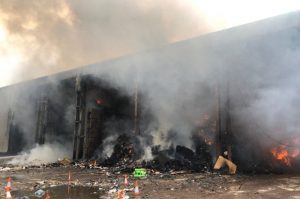 public as Christmas approached. The insurance companies picked up the final bill for the dispute with payouts totaling £117.5m compared with £52.3m for the same three months the previous year. The firefighters eventually settled for a 10% increase, taking an average salary to just over £4,000, with the promise of more to come.
public as Christmas approached. The insurance companies picked up the final bill for the dispute with payouts totaling £117.5m compared with £52.3m for the same three months the previous year. The firefighters eventually settled for a 10% increase, taking an average salary to just over £4,000, with the promise of more to come.
Firefighters went on strike again in 2002/2003, in a long-running dispute which included a series of one day strikes over a period of several months. They finally ended with a 16% pay raise that was tied to a modernization package. The Fire Brigades Union chief, Andy Gilchrist said at the time of the settlement it was “a first phase” towards raising a fire officer’s basic pay to £30,000. I say, it was about time.
 When people are having a bad day, or the worst possible day, people often don’t know what to do to help. And sometimes there is seemingly nothing that can be done to really help, but as most of us know, whether we realize it or not, there is always one thing that can help…a hug. Of course, there is a right time and a wrong time to give a hug, but once the emergency part of a situation is over, we are often left with overwhelming emotions, and they are often held in because we are trying not to do the one thing that we really need to do…cry.
When people are having a bad day, or the worst possible day, people often don’t know what to do to help. And sometimes there is seemingly nothing that can be done to really help, but as most of us know, whether we realize it or not, there is always one thing that can help…a hug. Of course, there is a right time and a wrong time to give a hug, but once the emergency part of a situation is over, we are often left with overwhelming emotions, and they are often held in because we are trying not to do the one thing that we really need to do…cry.
Over the years during which I was a caregiver, and now with what I went through during my husband’s heart attack, I have had a number of situations where the ambulance had to be called. In the whirlwind that followed, I had to keep my composure and tell the medical personnel what happened, and any other pertinent information they needed. I could not let myself break down. I couldn’t cry…or scream, which is what I really wanted to do. I had to hold it together, because my parents, in-laws, and then my husband, needed me to hold it together. I was their voice. Then, as suddenly as the ambulance had arrived, they loaded up their patient, and headed out. I found myself standing there alone, feeling very small and very scared. Then, a firefighter, who had also been dispatched, men who thankfully knew me because my husband had been their mechanic, came up to me and hugged me and encouraged me. Yes, the tears flowed then. There was no longer a need, nor any possible way to hold them back. Those firefighters can’t possibly comprehend what that hug meant to the person who received it. Hugs allow the emotions to release. It is the much needed human contact, when I felt entirely alone.
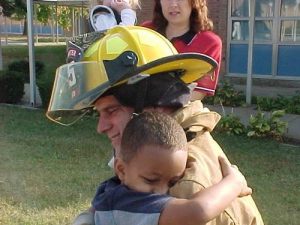
I am blessed to have many good people in my life. People who understand how badly a hug is needed. People who understand the power of a hug. My boss, Jim Stengel and his wife, Julie; my co-worker, Carrie Beauchamp; my siblings and in-laws; a friend and client, Donna LePage; and then, unexpectedly, my boss’s sons, Anthony and Michael Stengel, all sensed that I could really use a hug, and the power of those hugs has continued to help me. Each hug meant more than the giver can ever imagine. Each hug was given when the giver didn’t know what else to do, and yet each did exactly the right thing!! They instinctively knew that hugs are always healing. That is just the power of a hug.
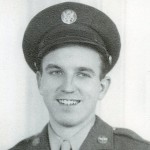
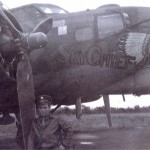 A number of years ago, I requested my dad, Staff Sergeant Allen Lewis Spencer’s military records from the National Personnel Records Center (NPRC) in Saint Louis, Missouri, only to be told that the records had been destroyed by a fire in 1973. I hadn’t heard about this before, and so really knew nothing about the details, except that I would never be able to find any more records of my dad’s military service during World War II, other than the ones we had, which was comparatively little. I wondered how it could be that the only military records for all those men were stored in one building, with no back up records. I know computers were not used as often, but there were things like microfiche back then. Nevertheless, the records were lost…and the loss felt devastating to me.
A number of years ago, I requested my dad, Staff Sergeant Allen Lewis Spencer’s military records from the National Personnel Records Center (NPRC) in Saint Louis, Missouri, only to be told that the records had been destroyed by a fire in 1973. I hadn’t heard about this before, and so really knew nothing about the details, except that I would never be able to find any more records of my dad’s military service during World War II, other than the ones we had, which was comparatively little. I wondered how it could be that the only military records for all those men were stored in one building, with no back up records. I know computers were not used as often, but there were things like microfiche back then. Nevertheless, the records were lost…and the loss felt devastating to me.
When I heard about the fire that destroyed my dad’s records, it all seemed like the distant past, but in reality, it was during my high school years. Then, it just seemed like a bad dream…a nightmare really. I couldn’t believe that there was no way to get copies of those records. My dad’s pictures, one of which was signed by the pilot of Dad’s B-17, on which Dad was a top turret gunner. Those pictures and the few records are all we have of his war years, and to this day, that makes me sad.
The fire broke out on July 13, 1973 and quickly engulfed the top floor of the National Personnel Records Center (NPRC). In less 15 minutes from the time the fire was reported, the first firefighters arrived at the sixth floor of the building, only to be forced to retreat as their masks began to melt on their faces. The fire was that hot!! There was just no way to successfully save the documents that were stored there. The fire burned out of control for more than 22 hours…even with 42 fire districts attempting to extinguish the flames. It was not until five days later that it was finally completely out. Besides the burning of records, the tremendous heat of the fire warped shelves while water damage caused some surviving documents to carry mold.
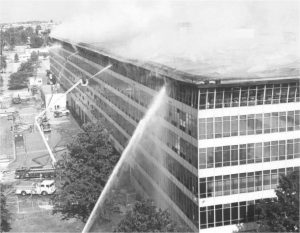
About 73% to 80% of the approximately 22 million individual Official Military Personnel Files stored in the building were destroyed. The records lost were those of former members of the U.S. Army, the Army Air Force, and the Air Force who served between 1912 and 1963. My dad joined the Army Air Force on March 19, 1943 and was discharged October 3, 1945. Many of the documents lost were from those years. They were gone, and there was no way to get them back. The National Personnel Records Center staff continues to work to preserve the damaged records that ere saved. There were about 6.5 million records recovered since the fire.
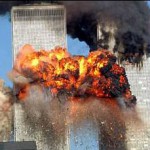
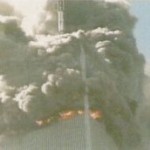 Sixteen years…that is the amount of time that has passed since the horrific 9-11 attacks on America. It’s hard to believe that so much time has passed. When I think about the victims of those attacks, I am saddened to think that the beautiful potential their lives had was stripped away from them in an instant. I think about the families they left behind to mourn their loss. And I think about the babies that arrived after the attacks, who would never know their dads. This year marks another milestone those babies will have without their dads…getting their driver’s license….as well as possibly dating. Their dads have missed so many milestones already, and it was just so unfair. Those men went to work that day, fully expecting to come home, but evil doesn’t care.
Sixteen years…that is the amount of time that has passed since the horrific 9-11 attacks on America. It’s hard to believe that so much time has passed. When I think about the victims of those attacks, I am saddened to think that the beautiful potential their lives had was stripped away from them in an instant. I think about the families they left behind to mourn their loss. And I think about the babies that arrived after the attacks, who would never know their dads. This year marks another milestone those babies will have without their dads…getting their driver’s license….as well as possibly dating. Their dads have missed so many milestones already, and it was just so unfair. Those men went to work that day, fully expecting to come home, but evil doesn’t care.
I think about the children who were lost in the attacks. Their lives were cut short before they even had a chance to grow up, and fulfill their life’s full potential. Some of them hadn’t even started school yet. They didn’t get the chance to graduate from high school, which many of them would now have done by now. Their 
 potential to be a productive member of society was squashed in a matter of a few hours on that September day, sixteen years ago, because evil doesn’t care.
potential to be a productive member of society was squashed in a matter of a few hours on that September day, sixteen years ago, because evil doesn’t care.
I am sad for the men and women, who worked in the offices of the World Trade Center, the Pentagon, who simply went about their day, doing the things they had planned, only to have everything ripped out from under them in a moment. Their futures were so bright. They were going places. They had studied and learned their trade, and now they were the people who were ready to go out and change the world. Their dreams were so quickly over. They would do no more. Their chance was gone. And the people on the planes, innocently traveling to their destination…forced to become a bomb in the plot to kill so many. Life for all of them ended that awful day, because evil doesn’t care.
I think of the emergency workers who ran into the buildings…the same way they always do in an emergency, fully expecting to bring the people out and save their lives. They ran in, but most of those who went in, did not 
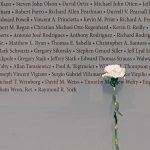 come back out that day. So many of the higher ranked firefighters had to be quickly replaced with firefighters who were less experienced in leadership, because the leaders were gone. So many people in so many areas of the United States and the world had to try to go on with the emptiness that was left by the loss of so many, in all walks of life. The nation had to rebuild…move forward…and deal with the feelings of grief, anger, and loss that the attacks left behind…that hate left behind, because evil doesn’t care about the life it destroyed. Evil just doesn’t care.
come back out that day. So many of the higher ranked firefighters had to be quickly replaced with firefighters who were less experienced in leadership, because the leaders were gone. So many people in so many areas of the United States and the world had to try to go on with the emptiness that was left by the loss of so many, in all walks of life. The nation had to rebuild…move forward…and deal with the feelings of grief, anger, and loss that the attacks left behind…that hate left behind, because evil doesn’t care about the life it destroyed. Evil just doesn’t care.
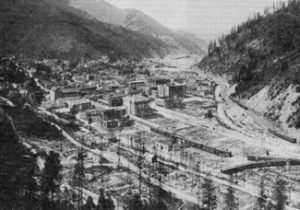
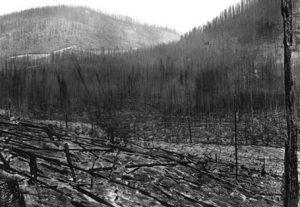 With summer, and especially late summer, when things are beginning to dry up, comes an increased danger of wildfires. Add to that, an extremely dry spring and early summer, and you have a recipe for disaster. Such was the case in northwest Washington, northern Idaho, and western Montana in 1910. There were a great number of problems that contributed to an over active fire season, and ultimately, the destruction that began on August 20, 1910, quickly became a firestorm that burned about three million acres…a full 4,700 square miles before it was over. The areas burned included parts of the Bitterroot, Cabinet, Clearwater, Coeur d’Alene, Flathead, Kaniksu, Kootenai, Lewis and Clark, Lolo, and Saint Joe National Forests. The extensive burned area was approximately the size of the state of Connecticut. The extreme scorching heat of the sudden blowup can be attributed to the great Western White Pine forests that blanketed Idaho. The hydrocarbons in the resinous sap boiled out and created a cloud of highly flammable gas that blanketed hundreds of square miles, which then spontaneously detonated dozens of times, each time sending tongues of flame thousands of feet into the sky, and creating a rolling wave of fire that destroyed anything and everything in its path.
With summer, and especially late summer, when things are beginning to dry up, comes an increased danger of wildfires. Add to that, an extremely dry spring and early summer, and you have a recipe for disaster. Such was the case in northwest Washington, northern Idaho, and western Montana in 1910. There were a great number of problems that contributed to an over active fire season, and ultimately, the destruction that began on August 20, 1910, quickly became a firestorm that burned about three million acres…a full 4,700 square miles before it was over. The areas burned included parts of the Bitterroot, Cabinet, Clearwater, Coeur d’Alene, Flathead, Kaniksu, Kootenai, Lewis and Clark, Lolo, and Saint Joe National Forests. The extensive burned area was approximately the size of the state of Connecticut. The extreme scorching heat of the sudden blowup can be attributed to the great Western White Pine forests that blanketed Idaho. The hydrocarbons in the resinous sap boiled out and created a cloud of highly flammable gas that blanketed hundreds of square miles, which then spontaneously detonated dozens of times, each time sending tongues of flame thousands of feet into the sky, and creating a rolling wave of fire that destroyed anything and everything in its path.
That summer had been described as “like no others.” The drought resulted in forests that were filled with dry fuel, which had previously grown up on abundant autumn and winter moisture. Fires were set by hot cinders flung from locomotives, sparks, lightning, and backfiring crews, and by mid-August, there were 1,000 to 3,000 fires burning in Idaho, Montana, Washington, and British Columbia. Then on August 20th, everything blew up into a firestorm. The firestorm burned over two days, August 20 and 21. It killed 87 people, most of them firefighters. The entire 28 man “Lost Crew” was overcome by flames and perished on Setzer Creek in Idaho outside of Avery. The Great Fire of 1910 is believed to be the largest, although not the deadliest, forest fire in United States history. It was commonly referred to as the Big Blowup, the Big Burn, or the Devil’s Broom fire. Smoke from the fire could be seen as far east as Watertown, New York, and as far south as Denver, Colorado. It was reported that at night, five hundred miles out into the Pacific Ocean, ships could not navigate by the stars because the sky was cloudy with smoke.
The fire actually started as many small fires. Then, on August 20, a cold front blew in and brought hurricane-force winds. The wind whipped the hundreds of small fires into one or two blazing infernos. The larger fires were impossible to fight. They simply didn’t have the manpower, or the supplies. The United States Forest Service…then called the National Forest Service…was only five years old at the time and unprepared for the possibilities of this dry summer. Later, at the urging of President William Howard Taft, the United States Army, 25th Infantry Regiment…known as the Buffalo Soldiers, was brought in to help fight the blaze. The most famous story of survival was that of Ed Pulaski, a United States Forest Service ranger who led a large group of his men to safety in an abandoned prospect mine outside of Wallace, Idaho, just as they were about to be overtaken by the fire. Pulaski fought off the flames at the mouth of the shaft until he passed out like the other men. Around midnight, one man said that he was getting out of there. Knowing that they would have no 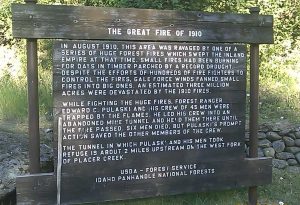
 chance of survival if they ran, Pulaski drew his pistol. He threatened to shoot the first person who tried to leave. In the end, all but five of the forty or so men survived. Several towns were completely destroyed by the fire. The fire was finally extinguished when another cold front swept in, bringing with it, steady rain. Unfortunately, it was too late for the 87 people who lost their lives in the blaze. Memorials were placed in several of the fire areas.
chance of survival if they ran, Pulaski drew his pistol. He threatened to shoot the first person who tried to leave. In the end, all but five of the forty or so men survived. Several towns were completely destroyed by the fire. The fire was finally extinguished when another cold front swept in, bringing with it, steady rain. Unfortunately, it was too late for the 87 people who lost their lives in the blaze. Memorials were placed in several of the fire areas.

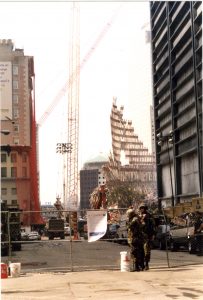 May 30, 2002 dawned, a typically warm New York City day, but this was not a typical day at all. It had been a long, emotionally grueling 8 months and 19 days of cleanup after the September 11, 2001 attacks on the World Trade Center, the Pentagon, and the crash site in Shanksville, Pennsylvania. The majority of the lost were in the World Trade Center in New York City. Those 8 months and 19 days were filled with every possible emotion there could be…from joy when one was found alive, to grief over the lost, to anger at the attack, to hate for the Muslim attackers, to love for the survivors and the families of the lost. It was something that we all knew that we could never really wrap our heads around, and something that we knew we would never forget. It was a senseless attack that proved only that the attackers were insane and filled with hate for Americans and Christians. It was a time when America came together as one, and donated time, money, letters, and love to each other, because we were all victims of this attack, after all.
May 30, 2002 dawned, a typically warm New York City day, but this was not a typical day at all. It had been a long, emotionally grueling 8 months and 19 days of cleanup after the September 11, 2001 attacks on the World Trade Center, the Pentagon, and the crash site in Shanksville, Pennsylvania. The majority of the lost were in the World Trade Center in New York City. Those 8 months and 19 days were filled with every possible emotion there could be…from joy when one was found alive, to grief over the lost, to anger at the attack, to hate for the Muslim attackers, to love for the survivors and the families of the lost. It was something that we all knew that we could never really wrap our heads around, and something that we knew we would never forget. It was a senseless attack that proved only that the attackers were insane and filled with hate for Americans and Christians. It was a time when America came together as one, and donated time, money, letters, and love to each other, because we were all victims of this attack, after all.
On May 29, 2002, the last beam was removed from the site…marking the end of the cleanup effort that had been expected to last a year. There were many disappointments in the cleanup, because there were very few people pulled out alive after that first day, and in fact, the last survivor was pulled out 27 hours after the attack. There would be no more lives saved. People were lined up to donate blood in the hope that someone’s life could be saved, but the sad reality was that very few whole bodies were even pulled from the rubble. Most were bits and pieces, body parts, and even just fragments of bone or teeth. Authorities put the final death toll from the World Trade Center’s destruction at 2,823. Of those 2823 people, only 1,102 victims have been identified, and only 289 intact bodies were recovered.
The ceremony…if it could really be called that, because ceremony usually means a happy event…began in silence. There would be no speeches. Thousands of people stood silently in one place…Ground Zero, and no one spoke…no one spoke!! The ceremony began with the sound of a fire bell ringing for the fallen firefighters at 10:29 am ET, the same time the World Trade Center’s north tower collapsed on September 11, 2001. Thousands of people stood in silence, some with tears streaming from their eyes, as an honor guard made up of police, firefighters, and representatives of other agencies walked slowly up a ramp from the site carrying a stretcher bearing only an American flag. The flag, symbolizing the victims who were killed on September 11, but never found, was placed into a waiting ambulance. It was followed by a flatbed truck carrying the last 50 ton steel column from the site of the Trade Center ruins. The beam was part of the southeast corner of the south tower. It was hoisted onto a flatbed truck and shrouded in black cloth after its removal on May 29, 2002. Ten minutes into the ceremony, a pair of buglers…one from New York’s Police Department, the other from the New York Fire Department…played “Taps,” followed by a flyover of NYPD helicopters. Among the dead following the horrific attack, were 343 New York firefighters and an estimated 70 police officers from various departments, including 37 from New York’s Port Authority and 23 from the New York Police Department. Fewer than half of the firefighters who died were recovered. Five of them were from the Chelsea Firehouse, Engine 3 and Ladder 12. At the fire stations and police stations in New York City, dozens of family and friends watched the tribute on television. Hundreds of workers had labored around the clock since September 11 to recover the 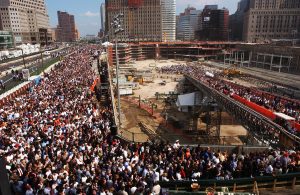
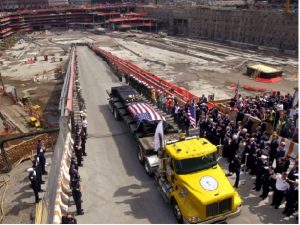 bodies of those who died in the attack and to remove the 1.6 million tons of steel and concrete left behind. The debris was moved to a Staten Island landfill, but reminders of the attack remain in the area. “It’s over, but it will never be forgotten,” said FDNY Battalion Commander Richard Picciotto, who was in the north tower when it was hit. He was right. Today marks the 15th anniversary of that ceremony, and we have not forgotten.
bodies of those who died in the attack and to remove the 1.6 million tons of steel and concrete left behind. The debris was moved to a Staten Island landfill, but reminders of the attack remain in the area. “It’s over, but it will never be forgotten,” said FDNY Battalion Commander Richard Picciotto, who was in the north tower when it was hit. He was right. Today marks the 15th anniversary of that ceremony, and we have not forgotten.
 Fifteen years ago today, Americans were greeted with horror, as terrorism split the atmosphere of safety we had long enjoyed around our nation. I think most Americans had become comfortable, and even complacent about national security. Life was going along at almost a lazy Sunday afternoon pace. We were like small town kids, who thought that nothing ever happens in our town. How very wrong we were. Our world was about to be turned upside down.
Fifteen years ago today, Americans were greeted with horror, as terrorism split the atmosphere of safety we had long enjoyed around our nation. I think most Americans had become comfortable, and even complacent about national security. Life was going along at almost a lazy Sunday afternoon pace. We were like small town kids, who thought that nothing ever happens in our town. How very wrong we were. Our world was about to be turned upside down.
When the first plane hit the World Trade Center, I think most people thought it was a tragic accident. We simply couldn’t fathom the idea that a terrorist would be so horribly cruel as to hijack a plane full of innocent people and fly it straight into a building full of more innocent people. And yet, to our horror, that is exactly what these terrorists did. They operated the planes with no mercy and no feelings. They did not care about the lives they were taking or even about their own lives…in fact, they thought they were heroes for their actions, and that there would be great rewards in Heaven for them. Their complete shock as they entered Hell, must have been devastating.
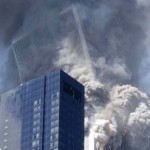 Their actions left our nation is shock and disbelief. We watch as the devastation unfolded before us, growing worse by the moment, our hearts and minds were assaulted, yet we could not look away. We watched, hoping that the people on the top floors could be saved…even after they began to fall or jump from the building, because the heat was more than they could take. We felt sick with each and every thud. We prayed over the rescuers, that they would be successful in getting people out, and that they would come out too. We watched in stunned disbelief as the towers fell, praying that after the first tower fell, that somehow, the second would remain standing…until it also fell. We became angry at the people who had done this, without provocation. Pure hate, of our beliefs, our prosperity, and our liberties, and that drove them to attack us.
Their actions left our nation is shock and disbelief. We watch as the devastation unfolded before us, growing worse by the moment, our hearts and minds were assaulted, yet we could not look away. We watched, hoping that the people on the top floors could be saved…even after they began to fall or jump from the building, because the heat was more than they could take. We felt sick with each and every thud. We prayed over the rescuers, that they would be successful in getting people out, and that they would come out too. We watched in stunned disbelief as the towers fell, praying that after the first tower fell, that somehow, the second would remain standing…until it also fell. We became angry at the people who had done this, without provocation. Pure hate, of our beliefs, our prosperity, and our liberties, and that drove them to attack us.
As the day went on, we watched in horror as more information came out. We knew that there were going to be  many people died, but still we watched as they dug through the rubble. We thought there would suddenly be people found alive in that rubble. As time went on, we knew that there wouldn’t be huge numbers of survivors. In the end, only twelve people were found alive after the towers fell. After a couple of days, we knew there would be no more, still we could not look away. We had to watch…had to know. As each lost one was found…we cried right along with their families. Then came the worst horror of all…finding out that some people would never be found. The fires had been so hot that their bodies were cremated. That added more horror to our thoughts. It was something we just couldn’t fathom, just like we could not fathom that 15 years later, that day would still be as vivid in our memories as it was on the day we were attacked.
many people died, but still we watched as they dug through the rubble. We thought there would suddenly be people found alive in that rubble. As time went on, we knew that there wouldn’t be huge numbers of survivors. In the end, only twelve people were found alive after the towers fell. After a couple of days, we knew there would be no more, still we could not look away. We had to watch…had to know. As each lost one was found…we cried right along with their families. Then came the worst horror of all…finding out that some people would never be found. The fires had been so hot that their bodies were cremated. That added more horror to our thoughts. It was something we just couldn’t fathom, just like we could not fathom that 15 years later, that day would still be as vivid in our memories as it was on the day we were attacked.

